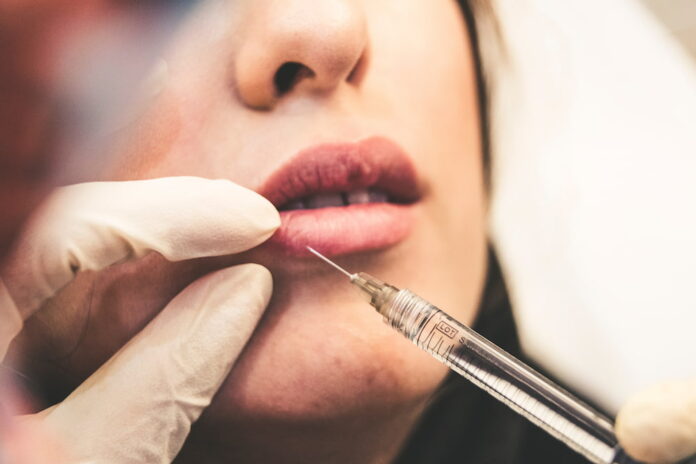Whether we like it or not, lip fillers have surged in popularity, offering individuals the chance to augment their natural features with relatively minimal intervention. However, with this surge comes a plethora of considerations, not least among them the cost.
Healthcare Business Club unpacks the average cost of lip filler procedures in the UK, digging into the importance of adopting a restorative rather than unrealistic approach to surgical procedures, and discussing the potential risks associated with excessive lip filler. Additionally, we’ll touch upon the benefits of non-surgical facelifts as a more natural alternative for those seeking to rejuvenate their appearance.
The Average Cost of Lip Filler in the UK
The cost of lip filler treatments in the UK can vary widely depending on several factors including the type of filler used, the volume of filler required, the practitioner’s experience, and the geographic location of the clinic. On average, one can expect to pay between £200 and £500 per syringe of hyaluronic acid filler, which is the most commonly used type of lip filler due to its safety profile and effectiveness. It’s important to note that most individuals will require one to two syringes per treatment session to achieve their desired outcome, though this can vary based on individual goals and anatomy
Breakdown of Costs by Procedure Type
Hyaluronic Acid Fillers: £200 – £500 per syringe. Most clients need 1-2 syringes.
Collagen Fillers: Less common and tend to be slightly cheaper, but the results are shorter-lived.
Fat Transfer Lip Filling: Can cost upwards of £1,000 since it involves a more complex procedure of harvesting fat from another part of the body and injecting it into the lips.
The Risks of Lip Fillers
The allure of fuller, more voluptuous lips has driven many to seek lip filler treatments, but it’s paramount to understand the potential hazards when these procedures are not performed by a professional. The risks associated with lip fillers are significantly heightened when administered by individuals lacking the requisite medical knowledge and experience. Complications can range from minor issues, such as unevenness and minor bruising, to severe, life-altering conditions.
Choose a Professional
Non-professional injections can lead to infection, necrosis (tissue death), and granulomas (inflammatory reactions). More alarmingly, incorrect injection techniques can cause filler material to enter the blood vessels, leading to blockages that can result in tissue loss or even blindness. Professional practitioners are trained to navigate the intricate vascular anatomy of the lips to mitigate these risks. They also possess the necessary skills to address any complications promptly should they arise.
Choosing a qualified and experienced professional is critical not only for achieving aesthetically pleasing results but also for ensuring your safety and health. Before undergoing any procedure, it’s essential to have a comprehensive consultation to discuss your goals, the details of the procedure, potential risks, and aftercare instructions.
The Importance of Restorative Procedures
In the pursuit of cosmetic enhancement, it is vital to prioritise restorative approaches over unrealistic expectations. The goal of any surgical or non-surgical procedure should be to enhance and restore natural beauty rather than to completely alter one’s appearance. This philosophy is particularly important in the context of lip fillers, where there’s a fine line between augmentation and over-enhancement.
Non-Surgical Facelift: A Natural Alternative
For those seeking a more comprehensive approach to facial rejuvenation, a non-surgical or volumetric facelift may offer a more natural-looking and holistic alternative. Unlike traditional facelifts that require invasive surgery, non-surgical facelifts use a combination of treatments such as dermal fillers, botox, and sometimes laser therapies to achieve a lifted, more youthful appearance. This approach allows for subtle enhancements that work in harmony with the natural contours of the face, often resulting in a more “real” version of oneself, without the need for extensive downtime.
One of the key benefits of a non-surgical facelift is its ability to address multiple signs of aging in a less invasive manner. By targeting specific areas of concern, such as fine lines, wrinkles, and loss of volume, individuals can achieve a refreshed and rejuvenated appearance that feels true to their identity.
Steps of a Non-Surgical Facelift
A non-surgical facelift is a combination of minimally invasive and nonsurgical procedures, designed to rejuvenate and refresh the appearance. The process typically involves several steps, tailored to the individual’s specific needs:
Consultation: The first step is a detailed consultation with a qualified practitioner to discuss your goals, assess your facial structure, and develop a personalized treatment plan.
Skin Analysis: An evaluation of your skin’s condition to determine the most effective treatments.
Cleansing and Preparation: The skin is cleansed and prepared for treatment to ensure optimal results and minimise the risk of infection.
Treatment Application: This can involve a combination of techniques, such as:
Injectables: Botox and dermal fillers to reduce wrinkles and restore facial volume.
Laser Therapy: To improve skin texture, tone, and pigmentation.
Ultrasound or Radiofrequency: To tighten the skin and stimulate collagen production.
Aftercare: The final step involves providing aftercare advice to manage any swelling or bruising and ensure the best possible outcome.
Each of these steps plays a crucial role in achieving a natural, refreshed look that aligns with the individual’s aesthetic goals. Unlike traditional facelifts, this approach requires no general anesthesia, incisions, or a prolonged recovery period, making it an attractive option for those seeking subtle enhancements without significant downtime.
The Final Word
The decision to undergo any form of cosmetic enhancement, be it lip fillers or a non-surgical facelift, should be made with careful consideration of the costs, benefits, and potential risks involved. It’s imperative to seek out reputable practitioners who prioritise patient safety and natural-looking results. Remember, the goal of cosmetic enhancement should always be to restore and enhance your natural beauty, not to conform to unrealistic standards or trends. By adopting a balanced and informed approach, you can achieve an appearance that feels authentically you, boosting your confidence and well-being in the process.
Read Also
- Optimizing CT Protocols: The Hidden Key to Efficiency and Cost Savings in RadiologyIntroduction: Why CT Protocol Optimization Matters Computed Tomography (CT) is a cornerstone of modern diagnostic imaging, providing critical information across nearly every medical specialty. However, maximizing the value of CT — both clinically and financially — requires more than just advanced hardware. The real secret lies in the optimization of CT protocols. When CT protocols… Read more: Optimizing CT Protocols: The Hidden Key to Efficiency and Cost Savings in Radiology
- The Role of Carbide Burs in Modern Dental ProceduresAs a result of this procedures need to be well coordinated and to this end, precision tools are used by dental practitioners. Among the most essential tools in a dentist’s arsenal are carbide burs, which have revolutionized various aspects of dental work. Today’s dentistry cannot work without these tools as they are both strong, sharp,… Read more: The Role of Carbide Burs in Modern Dental Procedures
- Detection of Diabetic Retinopathy: The AI AdvantageDiabetic retinopathy (DR) is a leading cause of blindness among working-age adults, affecting millions worldwide. The prevalence of DR is alarmingly high, affecting an estimated 34.6 million people globally. In the United States alone, it is estimated that 7.7 million adults have some form of diabetic retinopathy. How Does Diabetes Affect the Eye? Most of… Read more: Detection of Diabetic Retinopathy: The AI Advantage
- Advances in Digital Health: Transforming Modern HealthcareThe healthcare landscape is undergoing a seismic shift with the advent of digital health technologies. These innovations are not just modern conveniences; they are transformative tools that bridge gaps in accessibility, improve patient outcomes, and empower individuals to take charge of their health. From wearable devices to telehealth and artificial intelligence, digital health is creating… Read more: Advances in Digital Health: Transforming Modern Healthcare
- The Latest Advancements in Urology ProceduresUrology, the branch of medicine concerning the urinary system and male reproductive organs, has seen remarkable advancements in recent years. Technological innovations have led to more precise, less invasive, and increasingly successful procedures that promise better outcomes for patients. From state-of-the-art robotics to personalized medicine approaches, the field of urology is evolving at a rapid… Read more: The Latest Advancements in Urology Procedures






